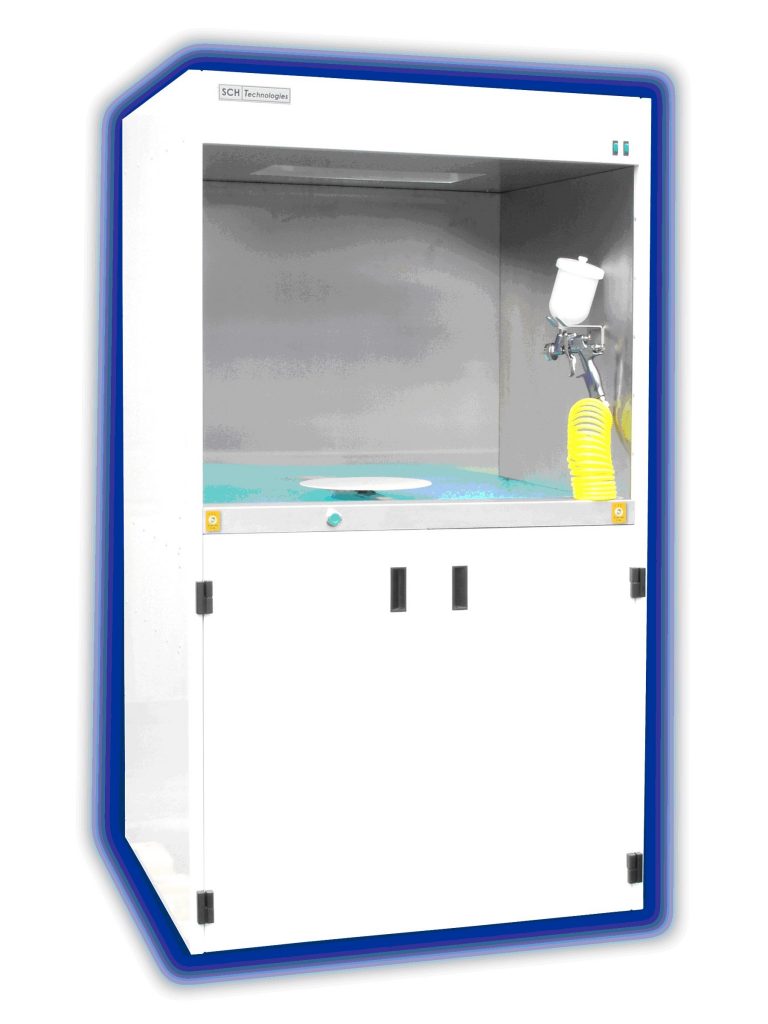Conformal Coating Equipment
Posted by Sean Horn
Friday, September 29, 2017 8:18
@ 8:18 AM
A variety of coating equipment is available for use in the conformal coating process. The most important machines for liquid coatings are described below.
Spray Booth
Dedicated spray booth conformal coatings are very cost-effective for medium- and higher-level production, with easy, even film application using a high-quality spray gun. Thorough ventilation is necessary to efficiently remove fumes generated by the process. Although manual spray coating is acceptable for low-batch assignments or rework, it is slow. Human error causing inaccurate application and varied coating thickness both generate rework, making manual spray less reliable for original coat. At the same time, manual spraying is suggested for assignments where components geographical layout will not accommodate a programmable spray coating approach.
Aerosol spray procedures can be automated for greater coating accuracy and faster production time. Manual and aerosol coating methods use liquid film material diluted with solvents to achieve an assignment-specific viscosity; spray application commences at a 45 degree angle, directed from all four quadrants.
Spray booth application produces surface finish quality often superior to all other methods. Repeat application generates optimal coating finish and protection. Robotics are increasingly used for high volume spray assignments. Whether the process is manual or automated, the objective is obtaining a combination of solvent dilution, nozzle pressure, and spray-pattern to meet assignment objectives.
Atomized spray coating provides a thinner film pass; however, if selectivity is required, application must proceed more slowly or the assembly’s edges will be left with a feathered/fuzzy film finish. In addition to multiple spray booths for higher batch assignments, Diamond MT employs a range of HVLP spray guns for manual spraying processes, to accommodate customers’ smaller orders.
 Dip Machine Processing
Dip Machine Processing
Dipped conformal coatings are frequently applied by automated conformal coating equipment. Dipping — immersing PCBs in a coating solution — is the most commonly-used liquid method, where high-volume turnaround is needed. Fast, dipping typically suspends an assignment-designated number of PCBs from a mechanical arm. Lowered into a dip-tank containing the liquid coating, their immersion rate is determined by total order-quantity.
Pre-dip preparation confirming no coating penetration into incorrectly masked keep-out areas is essential for dip machine coating. In addition to rapid processing, assured coating thickness is a major advantage of dipping. However, thin edge/tip coverage can result. Variables that need to be considered include rates of immersion/withdrawal, and viscosity of the coating material. Masking is always rather intensive, slowing the process.
Very efficient for conformal film application, automated dip coating can be readily adapted for all volume production, large or small. Completely submerging the PCB in liquid coating material contained in the dip-tank, this method ensures the entire assembly is covered, including underneath components and around 3D boards with difficult topography. Moreover, there is no waste of coating material with dipping or need for subsequent over-spray.
Drying Cabinet
The drying cabinet extracts air surrounding recently coated circuit boards, curing and storing them following film application. This stage of the process simultaneously dries PCBs and removes potentially hazardous fumes, left behind during coating. The presence of either
- particles trapped under the coating’s surface or
- uneven film thickness
- interfere with its purpose of providing the assembly’s specified conformal protection.
The drying cabinet helps eliminate these problems. Physically, each PCB unit within the cabinet is positioned to be stationary, minimizing contact of airborne particles with the coating surface. Perhaps more important, coating-flow is eliminated, so the wet coating does not develop areas of uneven thickness.
Conformal Coating Inspection Equipment
Studying the recently-coated PCB with intensified, long-wave UV lighting in an inspection booth is recommended. The dark, enclosed space provides an ideal environment for examining the still-fluorescing film. Conformal coating inspection equipment allows detection regions of the coating surface that require manual touchup. The inspection booth is also the station where electrostatic discharge (ESD) points are attached to the PCB, to prevent development of any ESD issues during operation.
At Diamond-MT, we utilize two inspection booths; one for inspection and one for coating touchup.
Comments
Homepage 4/17/2020. 10:17:10 AM
... [Trackback] [...] Informations on that Topic: blog.paryleneconformalcoating.com/whats-the-difference-between-potting-and-conformal-coating/ [...]

londondrugscanada.bigcartel.comlondon-drugs 4/17/2020. 10:17:10 AM
cialis uk https://londondrugscanada.bigcartel.com/london-drugs This is nicely expressed. !